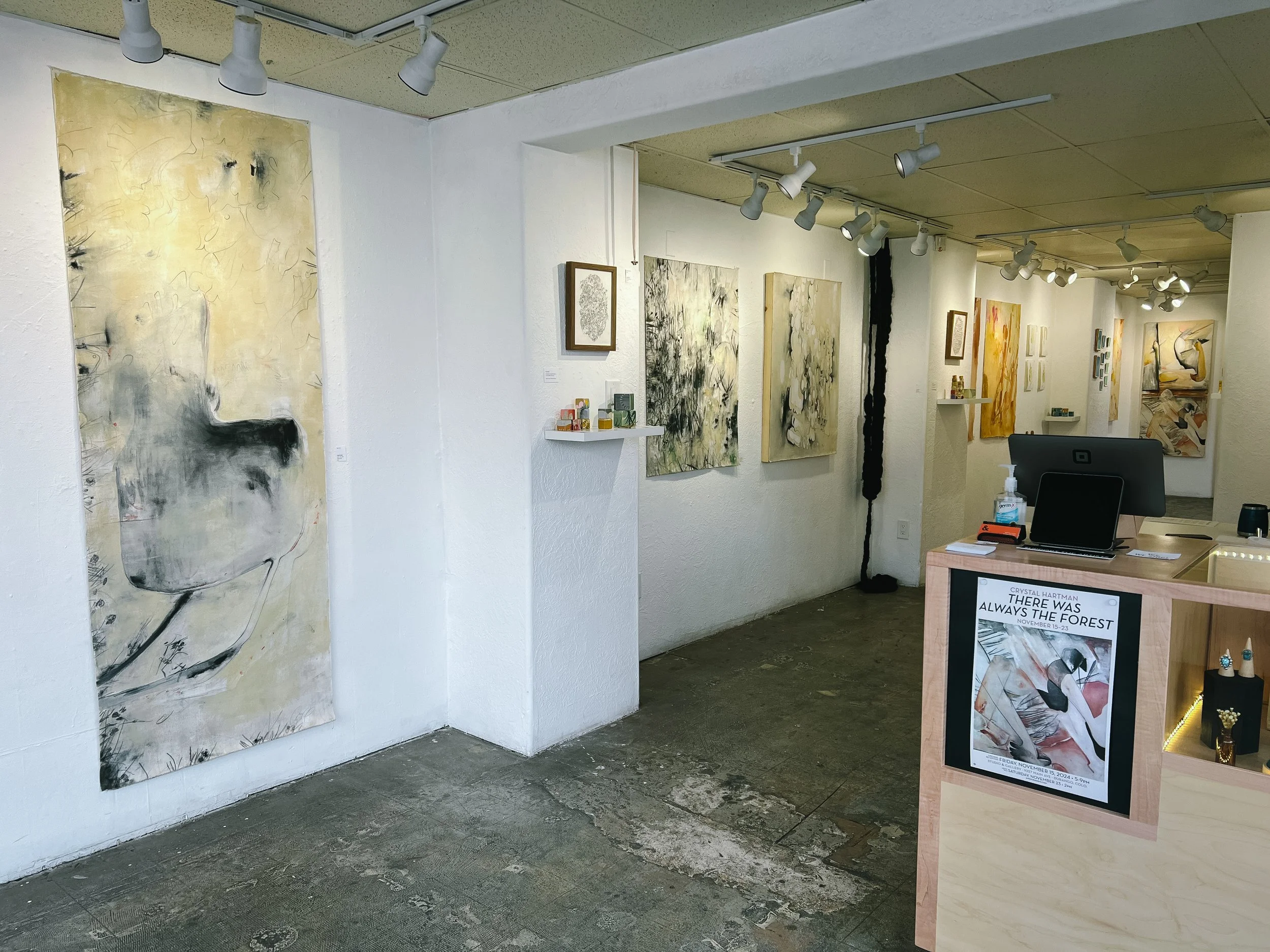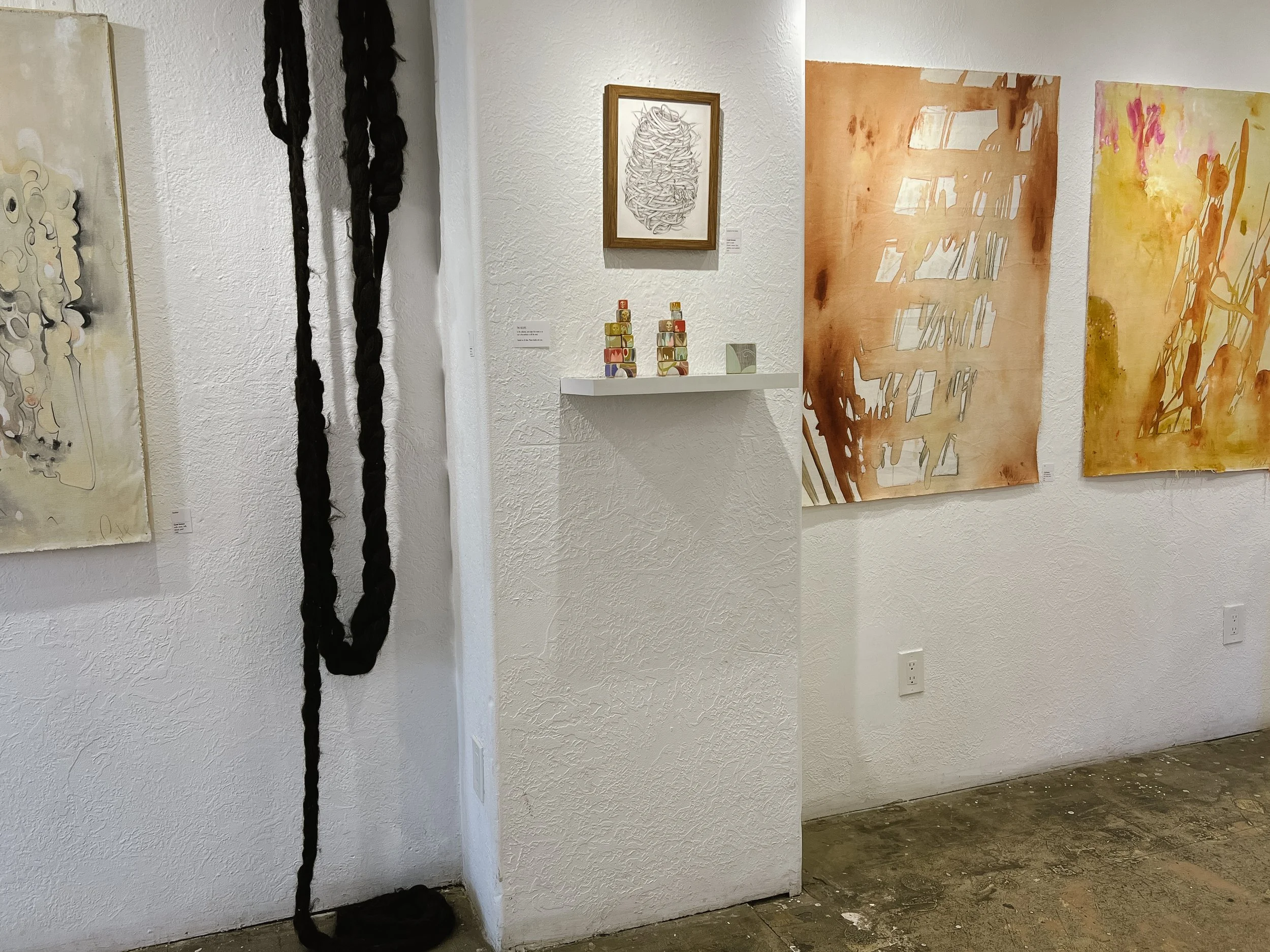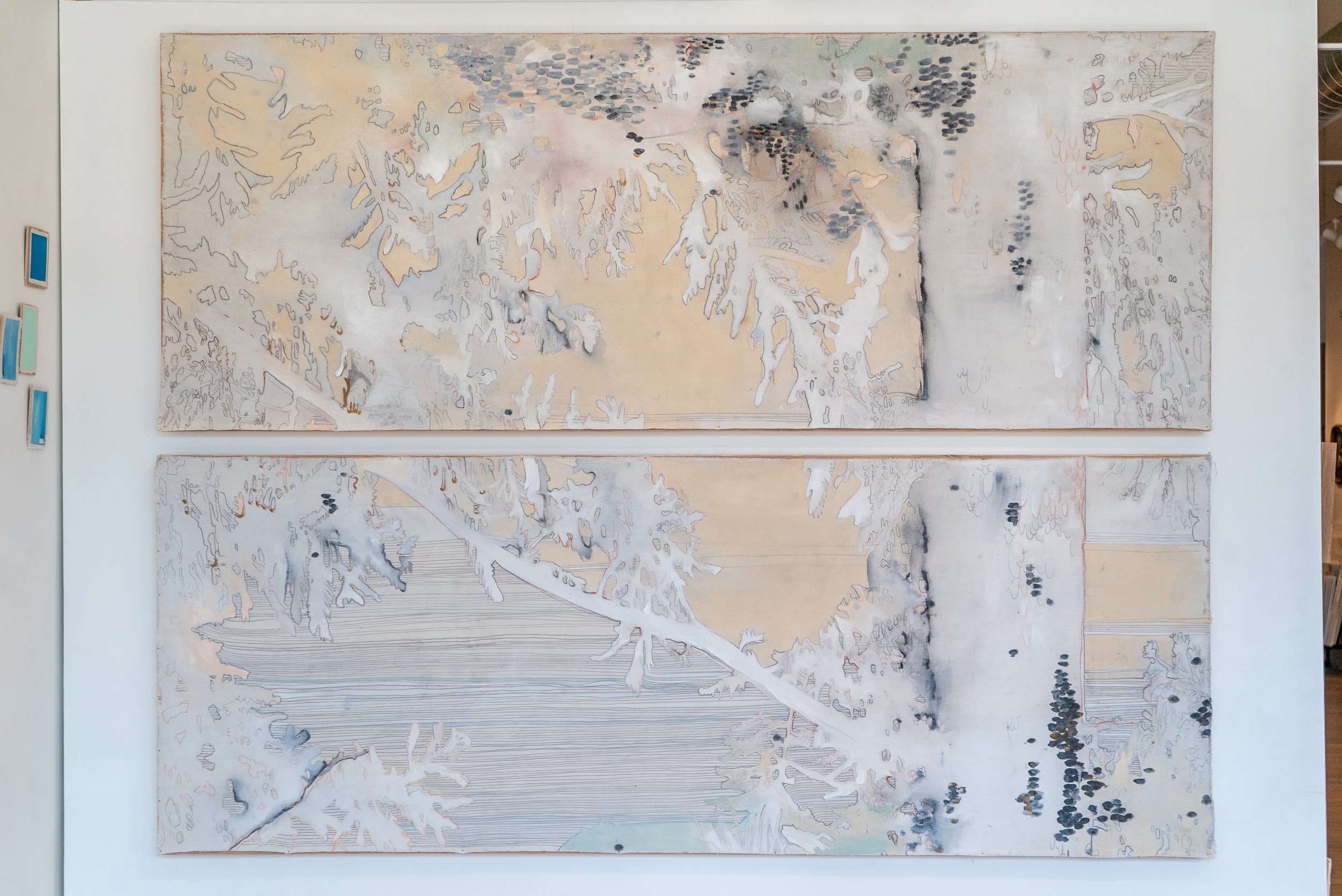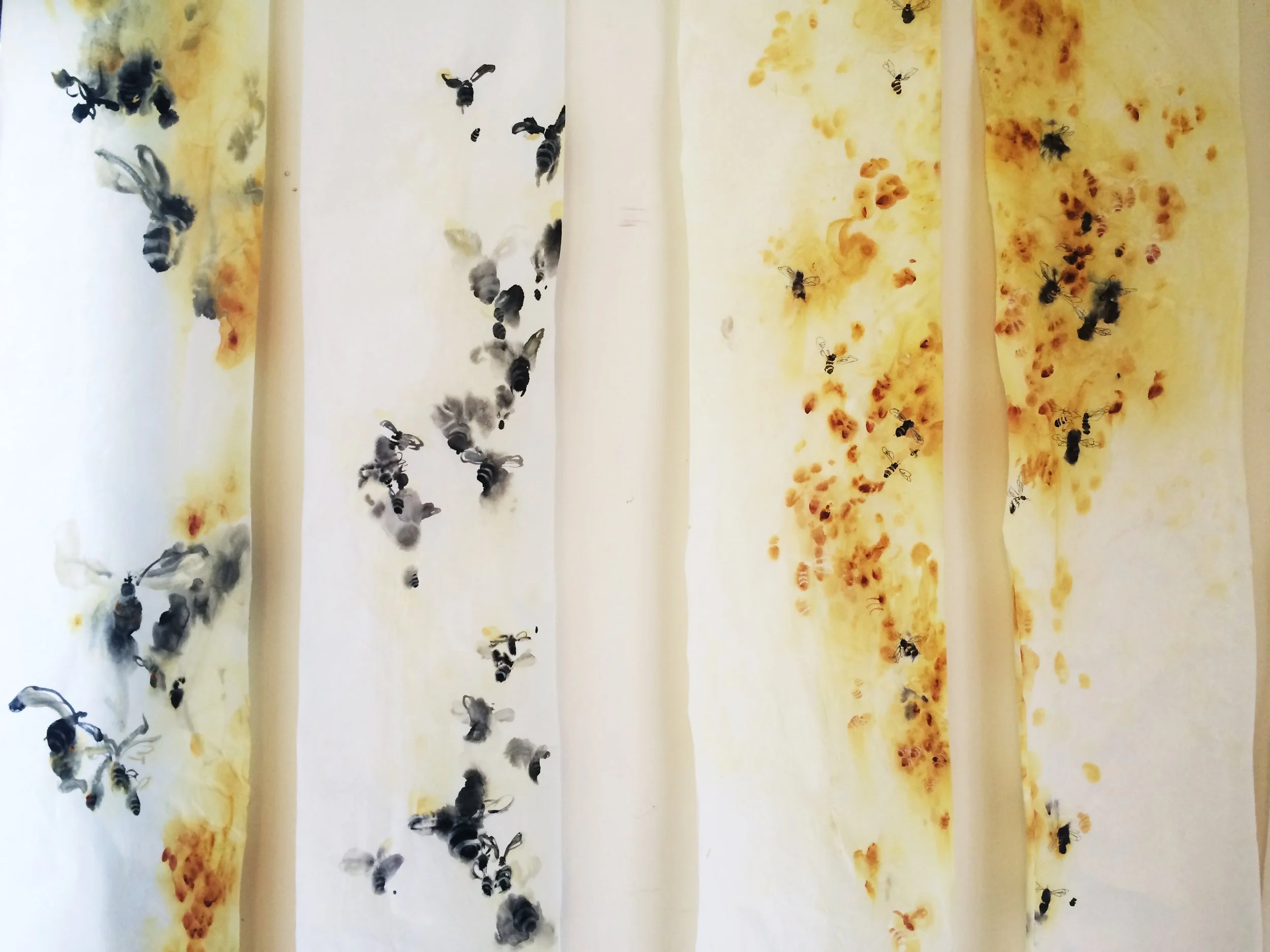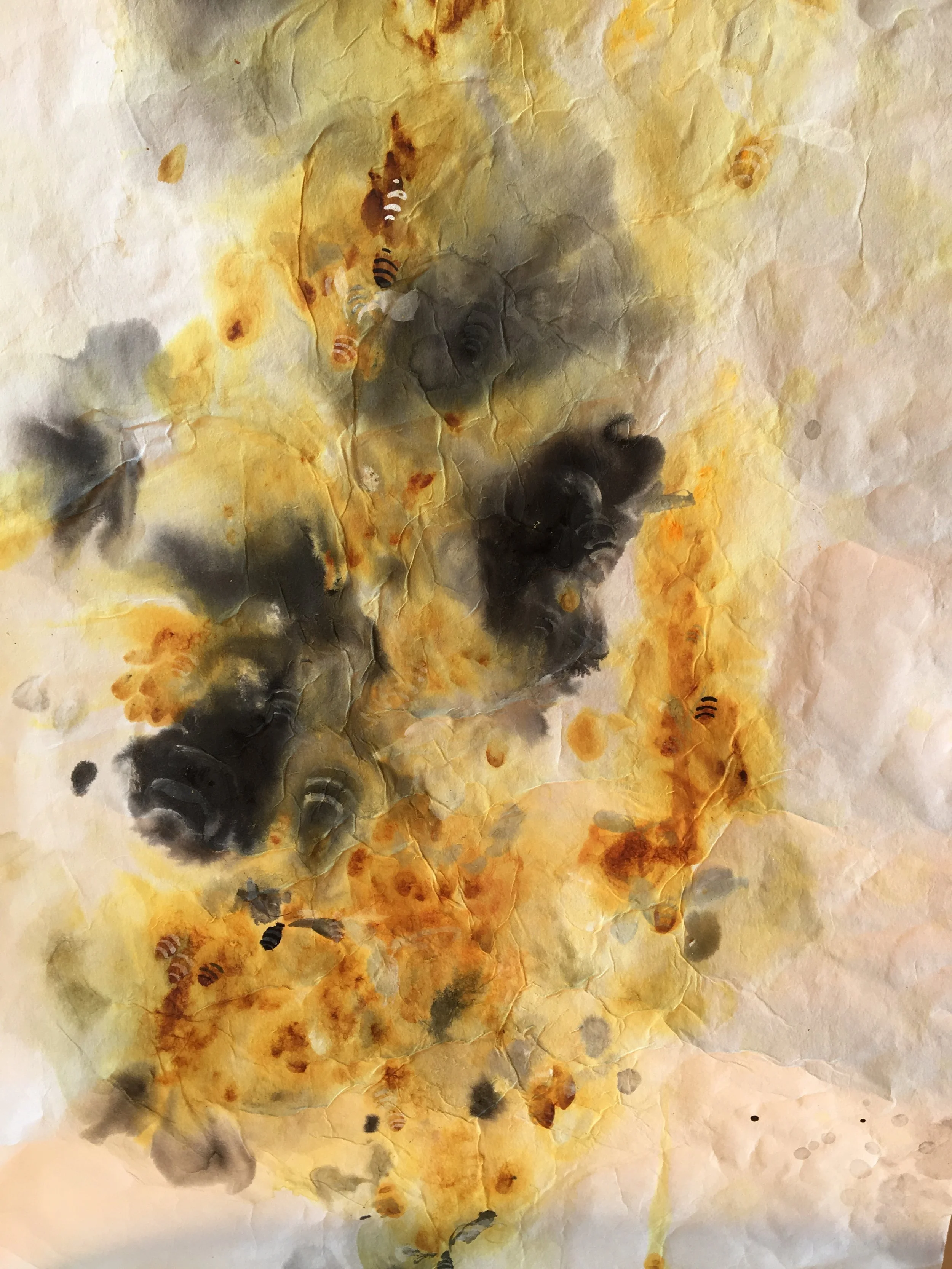With the trees and high-desert as our guides, this body of work invites viewers into social and emotional landscapes, asking us to pause. Large raw canvases stretched with exposed findings on wood panels, painted with gouche and tinted with botanical dyes, depict the spaces between shadows and offer the viewer abstract doorways into conversations on environment and perspective. Clean, minimal watercolors depict the joining of humans and trees in I Am the Forest, You are the Forest, We are the Forest, presented without the barrier of glass. Sculptural reclaimed-wood blocks, painted, sanded, and waxed, offer possibilities of changing stories when we stack the characters in different ways and challenge our sense of play. Bronze slugs and moths tether us to the natural world as talismans and guardians of interconnectedness, helping us to see the light in the darkness.
Self-Portrait, (+ detail in exhibition poster) acrylic, botanical dye, canvas, chalk, charcoal, pencil
Steve’s Chair, acrylic, canvas, chalk, charcoal, pencil
Turf and Chandelier, acrylic, canvas, chalk, charcoal, pencil
…
Moths: Finding the Light in the Darkness, reclaimed bronze or silver, ethical silk… paired with Slugs
…
Rope, alpaca roving
Cocoon for the Grasses, pencil on paper
The Middle Distance, (wooden shrines) gouache, honey-based water-color, salvaged pine blocks, salvaged cedar blocks, wax
3am, acrylic, botanical dye, canvas, chalk, charcoal, pencil
Everyday is Tuesday, acrylic, botanical dye, canvas, chalk, charcoal, pencil
Human Pyramid
gouache and thread on canvas
A Precarious Balance
botanical ink, copper nails, gouache and wood with handmade box
Oak and the Ice
acrylic, botanical ink, chalk, charcoal, gouache and pencil on canvas
The Prairie, The Leap, The Lake, and Sea Change
acrylic, botanical pigments, chalk, charcoal, gouache and pencil on raw canvas
Crystal Hartman… and, The Bees
Illumin Arts, Durango CO, Autumn 2017-Spring 2018
The Bees
In the spring on the sun soaked, rich, red dirt that held my body, stuck in my hair and remains in my pockets and heart, I lay with the wild honeybees that carried me to their trees and changed a cold concept of nature and service into a warmth and harmony worth sharing. I began my studies of pollination while carving wax for sculptural jewelry, hoping to find a recipe that would lighten the process and embrace the natural inspiration within the lines, I found beeswax. Soaking in the science and conversation of honeybees, I reached out to Willowtail Springs where I found the space, wild honeybee trees and time to develop a process that shares the beauty of pollinators.
Inspired by the quiet and hum of life, by the accumulation of creatures that make life possible, and by the ripples in the lake that found their way onto handmade papers and scrolls, this series of pollinators was created over the course of several years. The illustrations are detailed meditations on life, the natural world we share, lines and repetition. The scrolls, all painted at Willowtail Springs, were created in a temporal process with honey-based watercolor, ink, charcoal, wine and tea.
Canary
Studio Colfax, Denver CO, Autumn 2016
“From the studio of in-house artist and jeweler, Crystal Hartman, we are excited to announce Canary, an exhibition of drawings and sculptural jewelry. Addressing the the rapidly changing climate and growing tension within across cultures as we move away from a life connected to the earth and deeper entrenched in technology, these pieces reflect the discomfort of change and the possibility of opening doors and stepping into the unknown with open hearts and harmonious intentions.
Pencil and ink figurative drawings offer self-portraiture portraying the emotional experience of moving through the world. Often exposed and raw, these images feel cathartic, leaving viewers with a sense of being not alone in the feelings that challenge and unnerve; yes perhaps we really are in this together.
Large abstract paintings with botanically dyed acrylic and gouache compliment the intimacy of the drawings with broad strokes and bold layering of imagery that washes over us like sound, reminding us of new angles from which we might move through these ever changing emotions, days, and seasons.”
(left)
Muse
pencil on Rives BFK
On a Sheet of Ice, a Flower
Crystal Hartman at Jackson Junge Gallery, Chicago IL, 2023
“The Jackson Junge Gallery is excited to announce their third solo exhibition of the year, “On a Sheet of Ice, a Flower” featuring the work from the studio of nationally acclaimed artist, sculptor, and storyteller, Crystal Hartman. This exhibition is an installation including photography, artist books, drawing and painting on canvas and paper, embroidery, and sculpture drawing from her lifelong connection with nature and energized by her encounter with the Bøyabreen glacier in Norway.
The body of work in this exhibition is a small sampling of what Crystal Hartman cultivates in her daily life. “Whenever I get to meet a person or a piece of my artwork ends up in a home with someone, what I want is for them to feel courageous and creative, and strong and expansive. I want to create opportunities.” Each piece in the show is described as a beautiful doorway into a conversation. An installation of locally sourced materials including midwestern oak panels, raw canvas, and natural indigo dyes crafted by the hand of the artist, “On a Sheet of Ice, a Flower” is a unique exhibition that follows an ancient tradition of storytelling to encourage human connection with the natural world. Even the smallest piece grows like a seed in the consciousness and allows the viewer to reframe their understanding of the world around them.
“On a Sheet of Ice, a Flower” is a rumination on how we can love from afar, and it is deeply rooted in the Midwest, but also deeply connected to all parts of the natural world. Hartman is writing love letters not only to the vast expanses that are glaciers, forests, fields, and oceans, but also to their inhabitants and the humans that have lived and cared for them for millennia.
Hartman begins by unveiling the connection between her current hometown of Urbana, Illinois which she refers to as “an island in the golden fields,” and a glacier in Norway. “Reflecting on the massive nature of glaciers and the way that they tear down mountains right in front of you, here in Illinois, it makes me think of how all of this land was shaped by glaciers.” The fertile land in the Midwest is enriched by glacial run off from times long past, just as Hartman’s work is enriched by lush colors and finely layered linework.
Initially struck by the beauty and the feeling of cold air radiating across her body where she faced the Bøyabreen glacier, Hartman’s mind soon began to wander towards the great concern that we have for glaciers as they melt from our world at an increasing pace. She describes a moment of confusion as she began to parse out her emotions, was it a deep sadness she was feeling? No, she was humbled by the experience of being in the presence of something so powerful, and yet so delicate. In “On a Sheet of Ice, a Flower” Hartman follows this thread of emotion from glacial decay through the many ways in which the actions of humankind leave marks on the landscape.
Hartman confronts this reality in one of the pieces, “The Leap,” a raw canvas painted with light hues out of which a bloody red footprint emerges. There is both a depth and a lightness to the piece, the image is beautiful, but the message is crucial; nature is resilient and will sprout beauty long after we have left, but we must be careful not to destroy what sustains us while we are here. There are few things that have been more destructive to the Earth than to have humans walk upon it. The artist does not shy away from this uncomfortable truth, but rather recognizes it and turns her energy towards creating beauty in collaboration with nature and fostering kindness in the world.
The natural balance between strength and delicacy is what Hartman has focused her lens on in “On a Sheet of Ice, a Flower.” “This artwork is very much about the environment and climate change and exactly where we are right now,” Hartman continues, “but if it’s “On a Sheet of Ice, a Flower” then I suppose the flower is hope.” To the artist, this feeling is a powerful invitation to use the imagination and something that she endeavors to channel through her artwork. She aims to allow her audience to approach what may be sensitive topics with a sense of joy.
The viewer will be greeted at the front of the exhibition by an offering of welcoming and a collection of Hartman’s poetry that she describes as something of a bibliography of her work. One will then find themselves being gently led through the installation by small paintings of local indigo dye layered on raw canvases and mounted on oak, scattered throughout the gallery space like seeds. On some of these canvases Hartman has stitched tiny representations of a human pyramid, symbolizing the strength and magnitude of what is possible through cooperation and connection.
“On a Sheet of Ice, a Flower” also contains several pieces referred to as ‘cocoons.’ To the artist, a cocoon is a safe and warm space that allows for rest as well as growth and expansion. A cozy bungalow surrounded by prairie, Hartman’s home studio serves as her personal cocoon where she practices and blooms alongside her partner. Within the exhibition, viewers will see intricately drawn cocoons of interwoven prairie grasses and oak leaves as well as a diptych of swirling water cocoons cradling two of natures most mysterious and joyful aquatic creatures, the narwhal and the beluga whale. Hartman describes these pieces as ‘landing spots’ in the installation, creating a grounding space among the artworks that allows one to rest. If this is an exhibition of doorways, perhaps Hartman’s cocoons are the benches along the path.
In addition to working in graphite and on canvas, Hartman is well known as a sculptor employing the lost-wax casting technique through which she carves her design into sustainably sourced beeswax to create a single use mold. “In art, as in life, we’re constantly building line on top of line. I used to think that if I was only carving wax, I would forget how to draw and never be able to find my way back, but what I’ve come to realize is that I just keep drawing and everything influences each other.” The installation will include some of Hartman’s sculptural work, such as a narwhal inscribed with verse, but she also keeps a collection of tiny cast-silver and -bronze sculpture at the Jackson Junge Gallery year round. A great lover of being able to carry feelings, objects, and emotion throughout one’s life, most of the small sculptural work that emerges from Hartman’s studio takes the form of jewelry.
“On a Sheet of Ice, a Flower” includes several works from Hartman’s recent ‘shadow series.’ A fascination with shadows has emerged from the artist’s sleepless nights over the last few years, “During the pandemic I would wake up at 3am and I couldn’t go back to sleep… I would trace the shadows coming in through our window from the streetlights or the moon or whatever was creating light that night.” Deeply invested in process-oriented work and intimately familiar with the need for patience in all things, Hartman has turned her lens to tracing shadows of the prairie. “I trace these shadows in the dark so they’re crazy, but in the morning, I finish those paintings.” She considers the connection between light and shadow, ice and earth, and finds that a feeling of interconnectedness only grows the more she continues to sit with it.
“Oak and the Ice,” on view in the exhibition, began as charcoal tracings of the shadow of trees and revisited until a painting of glacial ice began to emerge. The large work spans two canvases and contains marks representing sea change, or profound transformation, for the artist. These marks move from “Oak and the Ice,” off the large canvases and onto smaller ones that permeate the installation. Each piece has been profoundly transformed from conception to creation, just as the artist hopes to inspire a profound change in the way we approach conversations about our impact on nature. “I think that the hardest thing when it comes to the environment is that we do all care… It’s just that oftentimes when conversations related to the climate come up, it’s so scary and they feel so enormous that we become overwhelmed, and we shut down. We don’t know what to do and it makes us feel tiny.”
“On a Sheet of Ice, a Flower” aims to foster feelings of wonder and joy and allow the audience to be called to action through finding love and peace in their environment as well as foster an appreciation for the way previous generations have cared for the Earth. Crystal Hartman carries the truth; “all beings everywhere, happy and free,” through her creative and life practices. Hartman finds a profound love and power in sitting with this truth and feeling a sense of being connected to something larger than herself. The installation at the Jackson Junge Gallery is an invitation for all to share in this truth.”
(above left) Installation Detail, four scrolls honey-based watercolor and ink on handmade paper scrolls and Detail from Honey and The Bees
(above right) Detail from Feral Bees, -honey-based watercolor and ink on handmade paper scroll
The Fucking Monkeys
The Recess Gallery, Durango CO, Autumn 2017
The Monkeys (Artist Statement)
Like some waterfall, great gust, torrential inundating glimpse of the human shadow, pesky mosquito, bite of reality that I refuse to bow down to, the taboos of sexuality and self-love inspire the playfulness of monkey to leap onto paper and into eroticism.
The monkey is represented here as a totem reminding us of lightheartedness, untamed nature, and compassion. It offers us good luck, swinging its tail as a symbol of balance. Sexuality and self-love have for us become taboos constraining our bonds with others, limiting our abilities to express ourselves, creating shame and distrust. Offering a space for conversation, I hope to empower through love, to encourage laughter, joyful bliss, and the beauty in our natures to heal.
Snakes and Snowflakes
Raiders Ridge, Durango CO, Autumn 2016
Snakes… Possibly the oldest and most complex of all animal symbols the snake is a magico-religious symbol of primeval life force, of transformation and rejuvenation, an image of creativity, fertility, eternity and divine self-sufficiency. In the way snake moves we see undulating waves and landscapes, winding rivers and roots, the shedding of skin to begin anew, the spiraling of the cosmos.
Snowflakes… No two are alike.
(left)
Defense and Spine (detail of two pieces) acrylic, ink, barnwood, brass
Coming soon… images and details from:
2017 The Fucking Monkeys, The Recess Gallery, Durango CO (details and images)
2016 Canary, Studio Colfax, Denver CO (details and images…)
2015 Recurring Butterfly, Studio Colfax, Denver CO
2012 You are my Muse, Pagosa Springs Center for the Arts, Pagosa Springs CO




